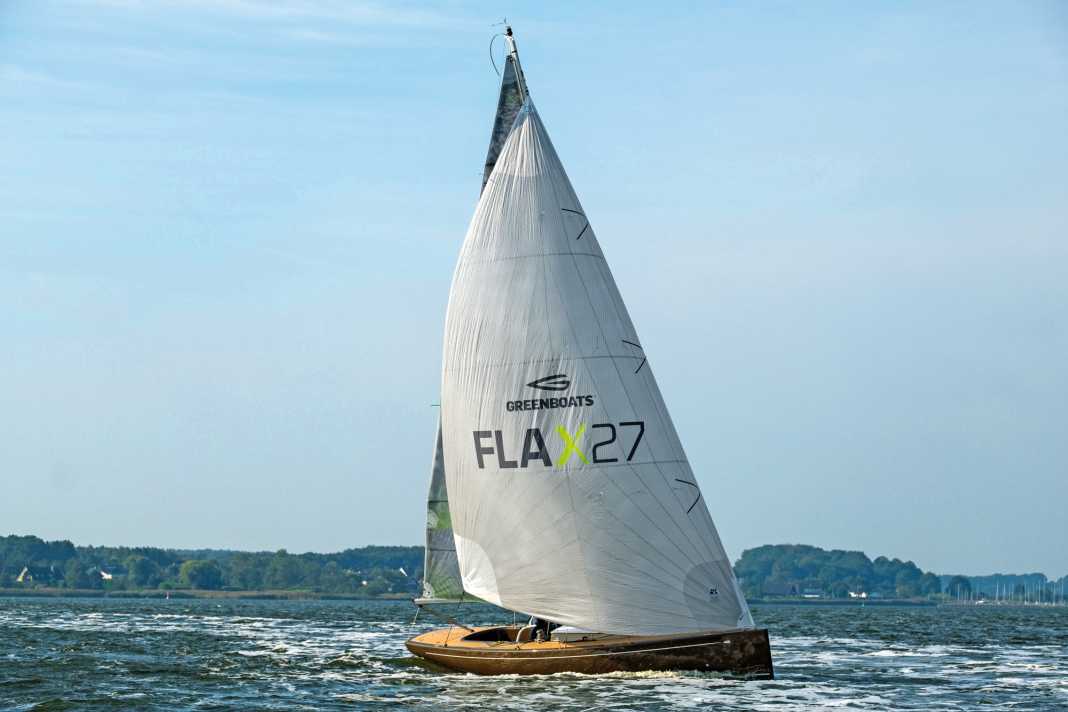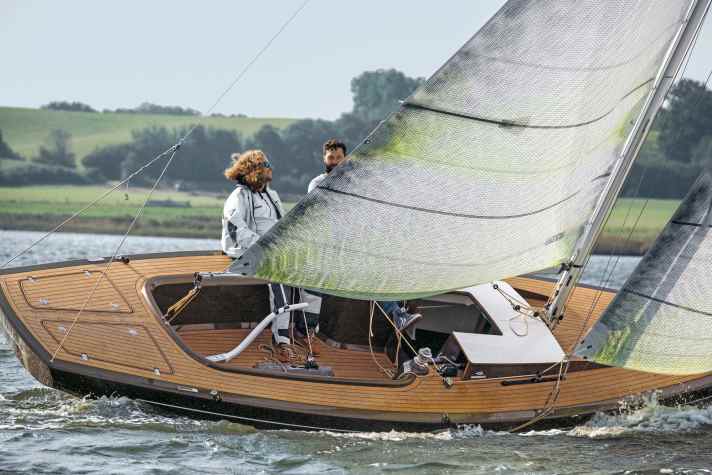Shipyard portrait Greenboats: Boats made of flax and components for Boris Herrmann
Fridtjof Gunkel
· 27.12.2023






The location may come as a surprise: Surrounded by building material wholesalers, a concrete mixing plant, waste disposal companies and car recyclers in the industrial estate of Bremen-Hemelingen on the Weser is the first address for sustainable, clean boatbuilding. At Hermann-Funk-Straße 10, one of the world's leading boat builders is at work.themost exposed and renowned shipyard for environmentally conscious watercraft: Greenboats. Friedrich Deimann from Bochum founded the company in 2013 and has continued to develop it with determination.
A visit to the shipyard. Striking feature 1: The estimated two-metre-tall master boat builder opens the door himself. With 15 employees, the division of labour at Greenboats is less pronounced, the hierarchy flat, the administration small, this is more of a craft than an industrial business. Striking feature 2: It smells - like nothing. No styrene, no other solvents from adhesives, resins or foams.
Glass fibre and carbon were out of the question for me, these materials are not sustainable"
Coffee, of course, just like office meetings, shipyard visits also start with coffee. In the small, unrepresentative meeting room full of material samples, Deimann talks about his apprenticeship at Fricke & Dannhus in Dümmer, where he discovered the handling of wood, classic production methods and the charm of small series. This was followed by a move to the Meyer yacht shipyard in Bremen, which manufactures motorboats, tenders for superyachts and components for aviation and shipping from high-quality fibre composites. Deimann: "I wanted to combine both worlds: Glass fibre and carbon were out of the question for me, these materials are not sustainable. I wanted to combine natural materials and modern production methods to create a sustainable product. In the end, I discovered flax fibres and new core materials."
Flax and its properties
In other words, flax. The natural fibre scores points in many disciplines. It starts with its cultivation. The main producer in Europe is France, where the plant from the flax family is mainly grown in Normandy. This eliminates the need for costly and CO2-damaging transport. The fibre, which grows back in very short cycles, is one of the oldest cultivated plants known to mankind. The first finds date back to the 4th century before the beginning of our era. Flax is used for oil extraction (linseed, linseed oil) and for fibre production. In earlier times, it was also used to make ropes, which is the origin of the nautical word linen.
Flax is quite stiff and tear-resistant and has a relatively low density. Furthermore, the natural fibre-reinforced composite (NFRP) hardly transmits vibrations and is resistant to impacts, shear forces and fatigue. Flax offers similar properties and strength values to mineral glass fibre, but is petroleum-based and leaves a larger carbon footprint during production. The production of one tonne of glass fibre releases around 1.7 to 2.5 tonnes of CO2. Natural fibres such as flax generate only 0.35 to 0.55 tonnes per tonne of the end product. This is an 80 percent better CO2 balance than glass fibres have.
Although further processing steps worsen this balance, the further processed products are still 50 per cent better. However, flax fibre is only one of these and is already being used by various shipyards, particularly in the main growing region of France, where manufacturers such as Outremer (high-performance catamarans), IDB Marine (performance offshore cruisers) and smaller specialists are working on the topic.
Greenboats strives for a good eco-balance right from the construction stage
However, Greenboats takes the most consistent approach to sustainability. In Bremen, they use foam made from recycled PET bottles as the core material, which is now available in various densities. But they also work with balsa wood, which is more challenging to process due to its susceptibility to moisture. Greenboats also uses cork as a core material, but this is significantly heavier than the alternatives.

The resin used is bio-epoxy, which contains up to 40 per cent natural ingredients such as linseed oil and enables particularly high-quality laminates. Overall, the approach of Friedrich Deimann and his crew differs from the endeavours of the French large-scale production yards from Groupe Beneteau: the Bremen-based company focuses on recyclable, but primarily durable, high-quality products that are already sustainable during production thanks to natural raw materials with a low carbon footprint. The French, on the other hand, are working on the recyclability of their yachts and want to build new GRP parts from them at the end of their life, preferably complete new boats, by making the composite materials separable. In principle, new components are to be made from the recovered fibres and resins.
Small cruisers and daysailers made from flax materials
Greenboats made a name for itself with an eco-version of the popular Bente 24, which was launched on the market in 2015. The small cruiser, designed by Judel/Vrolijk, is now produced by a Polish supplier under the direction of Meichle & Mohr from Lake Constance, usually using conventional sandwich laminate. Greenboats introduced a variant with flax-cork laminate in 2016. The immense surcharge of almost 24,000 euros compared to the standard version, which was available for 50,000 euros, was due to the higher material costs, but also the more complex construction method and the more expensive labour hours. In this respect, the comparison is not accurate, and "we will become more and more favourable in the future due to scaling effects," says Co-Managing Director Paul Schirmer, who points out that the advantages of the material already outweigh the disadvantage of the higher costs.
With the highly acclaimed daysailer Flax 27 Greenboats caused a furore. The design, also by Judel/Vrolijk, was consistently built to save weight and could be around 200 kilograms lighter than calculated for the use of glass, according to the shipyard. This is despite the widespread opinion that flax absorbs a lot of resin and thus increases the resin content. The shipyard has so far delivered four units of the extremely attractive boat. However, the price is also outstanding: the good piece with the transparent finish costs 200,000 euros.

A performance offshore cruiser for small crews is currently under construction, Working title 9 MB which stands for the length of the boat and the owner: Matthias Bröker is a designer at Judel/Vrolijk, a passionate ocean sailor and one of the spiritual fathers of the Dehler 30 OD. Nevertheless, he did not want to rely on the fibreglass boat and created a more moderate vessel that is tailor-made for his own purposes, including a cockpit that fits his body measurements. "The boat is more cruising-orientated without water ballast, with less draught and a conventional saildrive," says Bröker - and is also built sustainably.
Boris Hermann also relies on components made from flax
In addition to boats, Greenboats also supplies components. For example, on Boris Herrmann's "Malizia - Seaexplorer", 49 parts made of flat laminate such as hatch covers, bulkhead doors and components have travelled the world.
Greenboats has long been internationally recognised. Last year, the Bremen-based company won the World Sailing Federation's sailing environment prize with the unwieldy name World Sailing 11th Hour Racing Sustainability Award. From the citation: "... for the pioneering development and manufacture of products and components made from natural fibres that provide a viable sustainable alternative to conventional composite materials. This has the potential to completely change the footprint of sailing."
This has the potential to completely change the footprint of sailing"
They are working on it. And Greenboats is no longer just a shipyard, but also supplies materials as semi-finished products to other processing companies. These are prefabricated sandwich panels, scrims, pre-impregnated fabrics (prepregs) and laminates as well as rovings made from flax. Greenboats presses the panels itself and is currently in the process of taking a major step forward in this area.
The Bremen-based company is investing in a 40 metre long production line and is therefore looking for new premises. In the plant, the fibre material is dried, impregnated with bio-resin and compacted into a laminate panel under pressure and heat. The physical properties of the composite, such as stiffness, strength and weight, can be precisely controlled by selecting the core material.
Greenboats on the way from manufacture to industrial operation
At the end of the production line, trimmed panels measuring 6.00 by 2.40 metres are produced, which can be processed into bulkheads, furnishing components and partition walls. Not only for boats, but also for motorhomes, for example. The investment was made possible by a strategic minority shareholding in Greenboats by the French flax supplier Groupe Depestele. Europe's leading private flax producer claims to manage 13,000 hectares of cultivated land in Normandy. Depestele operates plants for primary processing, a combing plant and a production facility for composite reinforcements based on flax. With this investment, Greenboats is securing this increasingly popular raw material, particularly in a high technical quality that differs greatly from textile applications. At the same time, they are bringing further technical expertise on board with the French. With the investment and the new production facility, the Bremen-based company is taking the "step from a manufactory to an industrial operation", says CEO Paul Schirmer.
This is also where a third area of business leads. The team of three engineers specifies desired components such as a wallbox, a surfboard or a playground slide, produces the prototypes and Greenboats supplies the material, some of which is prefabricated, which is then processed for series production by another company that is more focussed on mass production.
Increased acceptance in society, growing demand, strong international partners, industrialised production and increasingly attractive offers - Greenboats seems to be on the right track. Friedrich Deimann: "Sustainability and environmental compatibility are a huge topic in society today, but ten years ago we were exotic. Time has caught up with us."
Example Flax 27: Fibres in comparison

The modulus of elasticity describes the strength of a material in relation to its weight. The higher the value, the stronger the material. Flax performs well in this respect. The frontrunner for strong, lightweight laminates remains carbon, which, like flax, is around 25 per cent more expensive than glass and is also not sustainable.
Modular system
Greenboats uses and sells self-made sandwich panels with cork, foam, balsa wood or honeycomb as the core material and various laminate coatings. The top layers in the standard dimensions of 6.0 x 2.4 metres will be manufactured on a new production line in future, which should reduce prices in the long term. The laminate layers will be bonded to the core material in a separate process step. A price example: a square metre of sandwich consisting of a 30 millimetre core and flat layers (400 grams per square metre) costs 182 euros.
Further topics in the sustainability special:
- 25 tips to help you sail more environmentally friendly
- These projects are available for marine conservation
- Sailing yacht vs. motorboat: which model is more sustainable?
- Boatbuilding ecolution: These shipyards are working on sustainable concepts
- Sustainable fashion: oilskins and other functional clothing - the best products
- Sail recycling: not just stylish bags - what happens to old cloth
- "Losing is not an option" - Boris Herrmann on sustainability in motorsport
- Sustainable management: Wooden boats in charter operations
- Equipment: Every sailor should reach for these green alternatives
- Drinking water on board: you can filter water correctly using these methods
- Baltic Sea: How does a harbour become sustainable?
- Research yachts: Climate protectors under sail
- Pallets, bottles, flip-flops: creative recycling ideas in boatbuilding
- Monsoon 31: Greenfit instead of refit, what does that mean for the 50-year-old Hallberg-Rassy?
- "Nomade des Mers": a catamaran as a low-tech laboratory
- Self-build yacht "Ya": Totally self-sufficient on a trip around the world
- Sustainable boat project: 55-foot catamaran made from recycled aluminium
- The Schwörer family and the "Pachamama": On a long voyage for climate protection
- Nike Steiger on her recycling project

